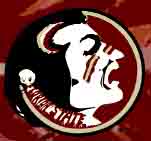 Some people say that when an Indian tribe approves a sports team's use of its name and image as mascots, that's all that matters. End of story. Sorry, but no, it isn't.
Some people say that when an Indian tribe approves a sports team's use of its name and image as mascots, that's all that matters. End of story. Sorry, but no, it isn't. Some people say that when an Indian tribe approves a sports team's use of its name and image as mascots, that's all that matters. End of story. Sorry, but no, it isn't.
Some people say that when an Indian tribe approves a sports team's use of its name and image as mascots, that's all that matters. End of story. Sorry, but no, it isn't.
The most famous case of a tribe's approving the use of its identity is the Florida State University Seminoles. The following postings explain some of the problems even when a tribe approves.
First, a message sent to Whit Watson, Sun Sports, and published 8/12/05:
As someone who has studied issues of Native American culture and politics for years, I would agree with you that the FSU "Seminole" issue is a bit more complex than that of other mascots. Nevertheless, even your more nuanced summary doesn't really do justice to that complexity. The Seminole Tribe of Florida has indeed sanctioned the use of the Seminole mascot, but you don't point out:
First, about 75 percent of the Seminole live in Oklahoma, and the Seminole govts there are vigorously opposed to the use of the name. 75 percent is a lot of Seminole people, and the NCAA has to take that seriously. Apparently you disagree, but you don't explain why. Instead, you assert without explanation that one Seminole tribal government of Florida has the only opinion that matters on the issue (and not the other two -- see point two below), and that the opinion of the majority of Seminoles "doesn't matter." I'm sorry; I just don't see how or why that should be true.
Second, there actually are three Seminole tribes in Florida, and only one tribal govt-the one which uses the name "Seminole Tribe of Florida" -- has formally signed on to the use of the mascot. I don't know the formal position of the other two Seminole govts, but it's wrong to misrepresent the opinion of one tribal govt as representing all Florida Seminoles.
Third, prior to getting the Seminole tribal endorsement, Florida State announced the establishment of scholarships covering 80% of tuition costs for "Seminole Scholars" recruited from reservations, and also announced plans to establish ties to a Seminole charter school and a branch campus in Immokalee, Fla. Florida State also has proposed the creation of a museum of Seminole heritage and culture on the Florida State campus. The minority of Seminoles who agreed to the use of the mascot benefit from a quid pro quo that doesn't do much for the other Seminoles. And if those things are so valuable, why have they only come up when FSU is trying to save its mascot?
Finally, though a lot of FSU fans insist that their use of the Seminole mascot is not offensive, FSU fandom is full of references to "scalping," "the chop," being "on the warpath," and so forth, and these caricatures undeniably demean and trivialize Native American culture.
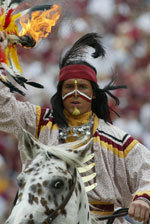
And when I say "undeniably," I mean that literally; there is simply no basis for denying it. These caricatures are specifically offensive because it was the caricature of Indians as savage and warlike -- a carefully constructed image of Indians as barbarians incapable of living side-by-side with the settler society -- that was used as the official reason from removing them from Florida (and elsewhere) and penning them up on reservations. People created these mascot images in the late 19th and early 20th century not as a way of celebrating local links to Indian cultures or local animals, but to extol the physical prowess of their team. The earliest team names were from large carnivores: tigers, lions, leopards, etc. The animal doesn't feel demeaned, of course, and the metaphor works because it doesn't intend to imply that the team is like wild animals in all aspects of their life, only that they play with vigor and intensity similar to that we associate with peak predators. The step from wild animals to Indian mascots was unfortunately small, given the prejudice and stereotypes about Indians at the time.
Now, there's nothing wrong with calling a person brave and celebrating physical prowess in combat. Similarly, there's nothing inherently wrong with a caricature of an ugly person who is stingy or a caricature of a goofy child eating a watermelon, but when the images are applied to Jews or blacks, it becomes offensive, because those Shylock and Sambo caricatures were popularized specifically as part of the dominant society's efforts trivialize and exclude certain other groups. The same is true here. The Seminole of the 19th century probably exhibited no more or less bravery and military skill than you'd find in most other cultures then or now. But whites explicitly justified their prejudices against the Seminole and other tribes by reducing their culture to only physical aggressiveness and ruthless fighting.
Let's be honest about the history of this imagery as we debate the meaning of the mascot. White society and the American government actually and intentionally said the Seminole were little more than fierce wild animals because this stereotype served the conscious plan to justify "removal," what we would now call the "ethnic cleansing" of the Southeast. For the heirs of those who did the ethnic cleansing to turn around and use that image as a source of amusement really isn't that funny, and can't really be justified as a celebration of the people who were the target of that removal.
An excerpt from Chris Lerch's column at US College Hockey Online:
Sept. 4, 2005
The Scrap Heap Of History
NCAA Wrong To Back Down On Mascot Ban
by Chris Lerch/Senior Writer
In the case of Florida State, while local tribe leaders are on the bandwagon, enjoying the recognition and notoriety that the association brings, many other Native Americans, including a large number of Oklahoma Seminoles, find the depiction of Chief Osceola offensive.
A bit of a history lesson is in order. The first half of the 19th century saw three wars between the United States and the Seminole nation, eventually ending in the slaughter and deportation of all but approximately 5,000 Seminoles to Oklahoma. The great Seminole warrior Osceola was illegally captured under a flag of truce by U.S. forces, and died in a South Carolina prison in 1838.
"Osceola hated American expansion into Florida," said Carol Spindel, a professor of writing at the University of Illinois at Urbana-Champaign in a recent interview with the Washington Post. "When he died in American custody, they chopped off his head for a trophy. Would he want to be a mascot?"
Osceola did not wear a headdress, ride a horse, or wear war paint, as he is typically portrayed by a white student during FSU football games. Yet, the Florida Seminole tribe (or at least the tribe's leadership) is fine with all this. Did I mention the financial support they receive in the form of scholarships?
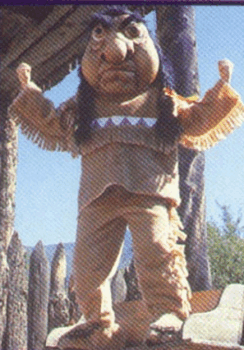
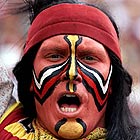
More on disapproving Seminoles
From the letters to Romenesko News:
Re: Native American mascot ban — unreported facts
8/12/2005 10:52:50 AM
From HAMILTON NOLAN: Being from Florida, I know that the NCAA's decision to bar Native American mascots from postseason championships is being taken by the faithful FSU boosters as a declaration of war. Jeb and the legislature are getting involved now, and the thing will probably reach Schiavo-like heights of ridiculousness before it's done. But in the hundreds of news stories about it quoting FSU's president touting the Seminole Tribe of Florida's support for the school's nickname, I haven't seen any making note of the extremely pertinent fact that there is another, equally relevant Seminole tribe in the state: The Independent Traditional Seminoles, i.e. the ones who have never made any treaties with the US government and continue to maintain their traditional way of life in the face of massive development of their native lands. I happen to know that the spiritual leader of the Independent Traditional Seminoles, Bobbie C. Billie, is vehemently opposed to the use of Native Americans as mascots and believes FSU is abusing his people's culture. In light of the fact that everyone from Jeb Bush to FSU's president is crowing about the "support of the tribe" and threatening to take the case all the way to the Supreme Court, shouldn't some reporters be looking into the fact that the Seminole Tribe of Florida doesn't represent the beliefs of many other Seminoles? Seems worth looking into.
From Darken Up, A-Hole: Reflections on Indian Mascots and White Rage (8/10/05) by Tim Wise, recounting a barroom discussion with a mascot fan:
True enough, the official Seminole nation of Florida is on record as supporting the use of their name at FSU. But of course, there are other Seminoles in the region who feel differently, not to mention the black Seminoles who have been all but disowned by those who consider themselves "true" representatives of the tribe. Indian politics are complicated, as it turns out.
Comment: Perhaps the best way to assess the Seminoles' opinion of FSU's Seminoles would be to take a vote. Of every tribe named the Seminoles. Of every member of these tribes, not just the tribal councils (who have a conflict of interest because they deal routinely with state governments). By secret ballot, not by opinion poll (because many people don't like to say no to poll takers).
If every Seminole tribe supported FSU's use of the name, it might be morally acceptable. But the name would still have problems, as the next section explains.
The NCAA's decision
When the NCAA opted in August 2005 to ban mascots in postseason play, many commentators asked why? In particular, they asked, how does the name "Seminoles" create a "hostile or abusive environment," as the NCAA claimed?
The answer to that question is pretty simple. The name "Seminoles" creates a hostile environment when a warrior on horseback throwing a flaming spear encourages fans to think of Native people as savage, bloodthirsty killers.
Not simple enough? We're talking about a freakin' spearchucker here. How sensitive do you have to be to realize a spearchucker is a hostile and offensive image?
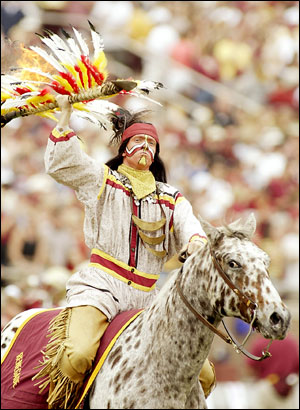
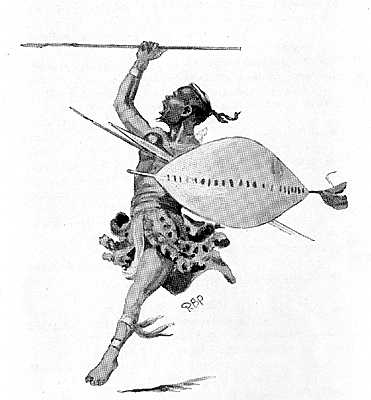
In short, the name itself isn't the main problem. It's the effect of using the name. It's the spearchucking mascot and the fans who believe he represents a real Indian.
Harjo tells us exactly how phony FSU's "Chief Osceola" mascot is:
It is shameful that the mighty Osceola is portrayed as a mascot. He is represented with fakey "war paint," which he never wore; on an Appaloosa horse, which he never rode; with a Plains Indian war lance, which he never used; acting the fool, which he never was; and performing for non-Indians -- which he never, ever did.
I'd add that the real Osceola wasn't a chief either. That all important Indians are chiefs is another stereotype. And Indians didn't have a ruddy complexion as in the photo above—yet another stereotype.
So the Osceola mascot promotes a phony image of a Plains Indian riding a horse and tossing a spear. Should a Plains Indian be concerned with this? Why not, since the so-called Seminole is mimicking another Indian's culture? Every Plains Indian is at risk of being stereotyped.
More subtly, any instance of the "Indian as warrior" name, logo, or mascot is stereotypical if not offensive. Look at the images on this page. Whether drawn or photographed, these pseudo-Seminoles are angry and aggressive. Their painted faces and snarling mouths practically scream "War!" Why would any peace-loving Indian appreciate such imagery?
Indians were much more than merely warriors, so the warrior identity is one-dimensional. It's a stereotype that has caused untold harm to Native people. For more on this point, see Smashing People: The "Honor" of Being an Athlete.
For those who still don't get it
For those who still don't get it, I wrote the following essay. If anyone's interested, it's available for reprint <g>.
Spearchucking at Florida State: the Indian Mascot Issue
By Rob Schmidt
A correspondent who knows little about Indian mascots in sports asked me the following question:
"What if Indians are being admired for being brave, courageous, skillful, resourceful, and strong?"
My response: What a school intends with an Indian mascot and the message it actually conveys aren't necessarily the same thing.
When Americans attended minstrel shows featuring actors in blackface, they probably thought they were honoring the Negro's happy-go-lucky nature, musical ability, and sense of rhythm. What they thought they were doing and what they actually were doing were two different things.
I doubt anyone in the history of stage or screen has ever intended to put stereotypes on display. The issue is what messages people send despite their intentions, not how good and noble their intentions are.
Florida State "honors" the Seminoles with a scowling, warpainted Indian on horseback who throws a flaming spear at midfield. In other words, a spearchucker. If a half-naked Zulu warrior ran onto the field and chucked a spear, would that strike you as wrong? How exactly is the Seminole case different?
How does this phony act show Indians being brave, courageous, skillful, resourceful, or strong? If the mascot could beat the school record for the javelin toss, I might give him credit for being strong, but that's about it. The rest of the act takes no skill except not falling off the horse.
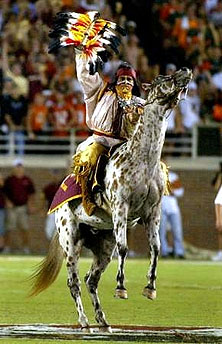
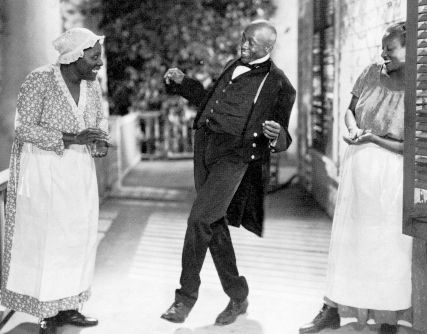
What it shows is an Indian being fierce, savage, and warlike. This is the meta-message of every mascot who portrays an Indian warrior. It's a one-dimensional stereotype that Indians have every reason to protest.
If the goal is to name a team after someone brave, courageous, skillful, and resourceful, how about the Police Officers? The Firefighters? The Soldiers? The Stealth Bombers? The Secret Agents? Etc.
For that matter, how about the Teachers? The Nurses? The Social Workers? The Working Moms? Etc. (If you haven't got the point yet, I could go on.)
Why don't teams use names like these? Because they suggest people who are brave, courageous, skillful, and resourceful but not fierce, savage, or warlike. When you look at the names schools don't choose as well as the ones they choose, you see the real message they're sending.
Again, that message is: "We want our athletes to be as violent, brutal, and ruthless as (we think) the Indians were. We want our team to crush, kill, and destroy their opponents like (we think) the Indians did." If you think about it, this is not a positive message.
Many teachers, nurses, or social workers would be insulted to be compared with hulking athletes. Why should an Indian—who may be a teacher, nurse, or social worker—feel any differently? What is it about the do-or-die, win-at-all-costs mentality that they should appreciate?
Being a warrior isn't something to embrace. It's something to do only after you've exhausted the alternatives. There are plenty of alternatives to spearchucking for sports.
Rob Schmidt writes on Indian and multicultural issues. For more information on mascots, go to http://www.bluecorncomics.com/mascots.htm.
More responses to critics
Additional comments from critics ranging from thoughtful to thoughtless:
Response:
Reflecting on the new policy, Florida Governor Jeb Bush remarked that the policy was "ridiculous," and suggested that members of the NCAA "need[ed] to get out more often." The republican governor asserts that this is not a serious issue; it is in fact a joke. Bush intimates those who would advocate the ban are ill-informed, cloistered, and/or overly serious, for if they were more in touch and aware, they could not possibly find symbols and names like those employed at Florida State University to be abusive or hostile. In his passing comment, Bush illuminates a key defense strategy: trivialize and dismiss critique; retain control of common sense understandings; refuse to talk about race.
C. Richard King, It's a White Man's Game: Racism, Native American Mascots, and the NCAA, Black Athlete Sports Network, 10/2/05

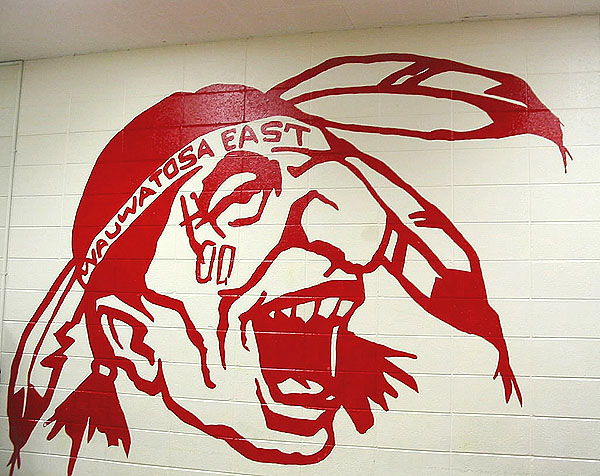
Comment: See Highlights of the US Report to the UN on Racism for more on the subject.
Response:
Native American scholar Vine Deloria wrote that of all the problems facing Indian people, the most pressing one is our transparency. Never mind the staggering suicide rate among Native youth, or the fact that Indians are the victims of violent crimes at more than twice the rate of all U.S. residents — our very existence seems to be in question.
"Because people can see right through us, it becomes impossible to tell truth from fiction or fact from mythology," he wrote. "The American public feels most comfortable with the mythical Indians of stereotype-land who were always THERE."
Rita Pyrillis, Sorry for Not Being a Stereotype, Chicago Sun-Times, 4/24/04
[Critics] come up with the ever-popular question: don't you have more important things to do for American Indians? No one who's ever asked that question is doing anything to help Native people.
Here's my question to everyone who's in a dither about the NCAA's decision: don't you have anything better to do than hang on to these toys of racism?
Suzan Shown Harjo, Harjo: The NCAA Is Learning What It's Like to Be Indian, Indian Country Today, 8/11/05
Response:
Children are being harmed by these mascots, and not just the Native American children. Once the stereotype is established in a student's mind, it makes it very difficult for children of any race to learn about present day Native Americans. For instance, I have been asked by school children if I still live in a tipi, and I have been told by a young school aged child that I can't possible be an Indian, because Indians were all killed a long time ago, and that's why the school mascot is an "Indian"—so Indians can be remembered.
Mike Wicks, MASCOTS -- Racism in Schools by State
Comment: Many Indian leaders have said stereotyping is among the worst problems facing Native people. Its dehumanizing effects lead to related problems such as alcoholism and suicide. See The Worst Native Problem, The Harm of Native Stereotyping: Facts and Evidence, and Quotes on Native Stereotyping for their testimony on this point.

Response:
The use of polls, for example, collapses democracy to the tyranny of the majority, suggesting that questions of proper action and just relations might be reduced to a popularity contest. Would we change our assessment of the African slave trade if slaves could be found who supported it? Would we condone genocide if some portion of those being cleansed spoke out in favor of it because they received political rewards or social esteem?
C. Richard King, It's a White Man's Game: Racism, Native American Mascots, and the NCAA, Black Athlete Sports Network, 10/2/05
Comment: See The Sports Illustrated Poll on Mascots and The Many Voices of Opposition for more on the subject.
Response:
An equally troubling set of questions emerges when one ponders when the views and values of American Indians matter. Why is this one of the few issues where they are consulted? And more, if the majority of Native Americans supported the return of the Black Hills or the payment of reparations to survivors of boarding schools, would EuroAmericans so quickly embrace their opinions?
C. Richard King, It's a White Man's Game: Racism, Native American Mascots, and the NCAA, Black Athlete Sports Network, 10/2/05
Comment: Good point. If we're going to put mascots to a vote of Indians, let's put every issue on the table to a vote of Indians. Let's see how the Seminoles, the Lakota, and other tribes feel about the US enforcing the treaties it broke and returning the land it stole. If non-Indians will abide by the results of those votes, Indians will abide by the results of a mascot vote.
Besides, who says Florida's Seminoles are the only ones who get to weigh in on the issue of Native stereotyping? What about Oklahoma's Seminoles, or Indians in general—all of whom are affected by any stereotyping? See the rest of this posting for more on the subject.
Response:

Somewhat ironically, supporters of Native American mascots have suggested that the NCAA is silencing American Indians, refusing to recognize them as citizens and their tribes as sovereign. Again, when Indians matter is telling; they are meaningful when it is convenient for white individuals and institutions, and especially when they legitimate predominant versions of the white man's Indian. Thus, Florida State University celebrates one Seminole tribe, while ignoring another. Similarly, the kind of power accorded to the Seminole is quite limited, if not illusory. They may grant permission, but they do not occupy a meaningful structural position that might shape the conception and implementation of educational policy or land development. They become little more than tokens and trophies for a white centered and white dominated university, intent to retain its Indian, and the immense profits and pleasures that image accords.
C. Richard King, It's a White Man's Game: Racism, Native American Mascots, and the NCAA, Black Athlete Sports Network, 10/2/05
Comment: Another good point. Why doesn't FSU consult the Seminole Tribe on all issues? Or at least on every issue related to Florida history, land and water use, and the education of Indians? If the Seminoles' opinion is so worthy of respect, respect it on every issue of importance to Native people, not just this one.
Response:
"What do you believe is the primary cause of anti-Indian sentiment?"
Indian Country Today poll of 450 American Indian opinion leaders, 10/18/00
Comment: True, the lack of unanimity is one argument. The counterargument is that if there's sufficient agreement in the Indian community, why doesn't somebody do something? If not the NCAA, then who?
More witless canards about mascots
Those were some of the more rational responses to the NCAA's decision. Here are some of the less rational ones:
Response: The NCAA didn't say "Seminole" and "Illini" are offensive terms. It said the names, logos, and (most important) mascots create a hostile and abusive environment.
How so? Well, "Seminoles" creates a hostile environment when a warrior on horseback throwing a flaming spear encourages fans to think of Native people as savage, bloodthirsty killers. See the rest of this posting for more on this point.
Most Indians weren't killers or even warriors. They definitely weren't spearchuckers a la the phony "Chief Osceola." So the "warrior" image is a stereotype and a false one at that. Opposing it isn't politically correct, it's historically and morally correct. It's correct, period.
Response: The Seminoles are a special case, but tribes have almost unanimously voted to condemn the Fighting Sioux and the Fighting Illini. Faced with this widespread disapproval, why haven't these universities acted?
If the NCAA sides with the tribes, its position is morally correct, not politically correct. In that case, it's the schools who should change.
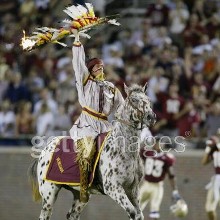
Response: Indians used to live in every state named after Indians, so the place names are geographically correct. College sports teams aren't composed of Indian students, so the team names are biologically incorrect.
In other words, critics are comparing apples and oranges. When a place not inhabited by Indians gets named after Indians—someplace in Europe or Asia, perhaps—then this point will be valid. Until then, no.
Response: Are critics seriously comparing Indians to wolverines, malamutes, and leprechauns? Tens or hundreds of thousands of Indians, including most tribes and tribal organizations, have denounced the use of Indian mascots. How many wolverines, malamutes, or leprechauns have said they're offended lately?
When they do speak up, we can take their views into consideration. Until then, everyone who offers this silly animal argument is comparing apples and oranges.
In fact, that critics would compare the responses of Indians to those of animals and imaginary people is vaguely disturbing. Are they saying that Indians' feelings are no more important than those of creatures we deem subhuman?
Response: Why would mascot advocates give up when they've accomplished so much? There used to be some 3,000 schools with mascots; now there are only 1,200. A few more decades of this "ongoing and ridiculous debate" and the problem will be gone—permanently.
The real question is why mascot defenders don't give up. Based on the success rate so far, they're on the losing side of history. They'll realize it eventually, even if it takes a generation or two for the remaining mascots to disappear.
FSU supporters prove how hostile and abusive they are
Ironically, an FSU trustee proved how mascots create a hostile and abusive environment by venting his hostility and abuse toward the Indians who didn't agree with him. From the St. Petersburg Times:
FSU trustee apologizes to tribe
The prominent lawyer says he was "insensitive' in dismissing concerns of Oklahoma Seminoles.
By STEVE BOUSQUET, Times Staff Writer
Published August 16, 2005
TALLAHASSEE -- Richard McFarlain's sharp tongue got the best of him at the worst possible moment.
As a result, the prominent lawyer and Florida State University trustee has apologized to the Seminole Nation of Oklahoma for remarks that offended a tribal leader.
"I think I just should have shut up," McFarlain said in a brief interview Monday.
As FSU officials met last week to counter NCAA criticism that its Seminole symbol is "hostile and abusive" to American Indians, McFarlain dismissed concerns by Seminoles in Oklahoma.
"They got run out of here by, who was it, Andrew Jackson or somebody like that? The veil of tears?" McFarlain said. "The real Seminoles stayed here."
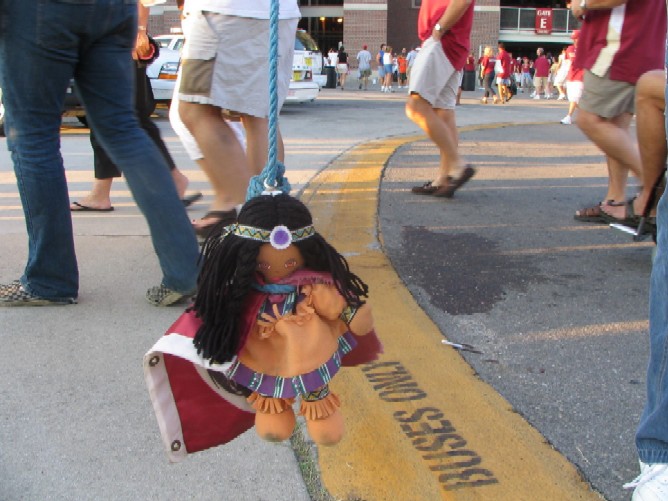
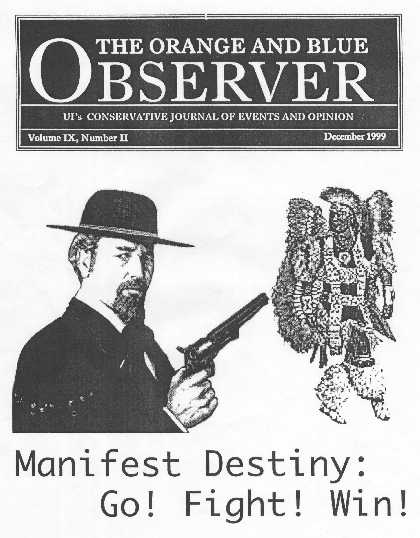
The "Trail of Tears" is the term often used to refer to Cherokee Indians forced from their homes and driven west in the 1830s, the result of Jackson's Indian Removal Act.
The university, which defends the use of the Seminole name as respectful and dignified, issued a written apology from McFarlain.
"I made some comments after Wednesday's Board of Trustees meeting that I realize, in retrospect, were insensitive to many people and members of the Seminole Nation of Oklahoma in particular," McFarlain said. "I have great respect for the Seminole people of Florida and Oklahoma, and I did not mean to cause offense. I apologize for my comments and look forward to having as positive a relationship with the Seminole Nation of Oklahoma as we do with the Seminole Tribe of Florida."
A spokeswoman for the Seminole Nation of Oklahoma referred questions to Ken Chambers, the principal chief of the tribe who had called on McFarlain to apologize. Chambers could not be reached.
McFarlain, known for a quick wit and fondness for bow ties, has practiced law for four decades. He's a former general counsel to FSU, a former chairman of the state's Judicial Qualifications Commission, and has served on the ethics committee of the American Bar Association.
He made his remarks before an emergency FSU trustees meeting last Wednesday. As reporters interviewed FSU officials, McFarlain at first made references to the familiar Seminole spear.
"If it were up to me, I would tell them what to do with their spear," he said.
Asked if the NCAA should go further and ban Notre Dame's "Fighting Irish" nickname, he said: "Well, now, I'm Irish, and it doesn't bother me. That's what we do."
Then he said the NCAA should prepare for a long battle because university president T.K. Wetherell is "not a kiss-and-make-up type of guy. You want a fight, he'll give you one."
More supporters mouth off
Then a couple more FSU supporters joined in. From the Miami Herald:
Posted on Tue, Aug. 16, 2005
Don't know much about history. . .
OUR OPINION: INSULTING TO MAKE LIGHT OF GENOCIDE AGAINST INDIANS
Three prominent Floridians, ardent Florida State University boosters, have embarrassed all residents of the state with their insulting, ignorance-riddled comments about the infamous "Trail of Tears" and the Seminole Tribe of Oklahoma. They owe more than an apology to the Oklahoma Seminoles. They owe one to Floridians, too. Then the three — state Sen. Jim King and FSU President T.K. Wetherell and trustee Robert McFarlain — should sign up for an American-history course at the college they so errantly tried to defend.
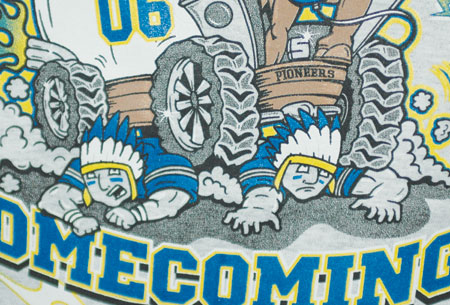
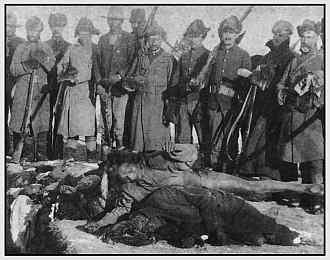
Disparaging comments
The three indulged in incorrect and offensive comments about the Oklahoma tribe last week after the NCAA announced restrictions on college displays of American Indian nicknames and imagery, including FSU's Seminoles sports teams. Believing that the Oklahoma tribe officially opposed FSU's use of their name, while the Florida Seminole Tribe supports it, Messrs. King, Wetherell and McFarlain made disparaging comments about the Oklahomans, whose ancestors were victims of the genocidal U.S. government policy of the 1800s known as the Trail of Tears. The government force-marched thousands of Indians from their ancestral homes west to Oklahoma. Countless people died along the way in one of the country's more shameful chapters.
About 200 Seminoles escaped to Florida and waged a long war with the U.S. government. They are the ancestors of today's Florida Seminoles.
Inveighed Mr. McFarlain about the Oklahomans: "They got run out of here, by who was it, Andrew Jackson? The Trail of Tears. The real Seminoles stayed here." For good measure, he added that he could "care less what the Seminoles in Oklahoma think." Here's Sen. King: "They're the ones that gave up and went to the reservation," about the Oklahoma tribe. President Wetherell, in a comment about the NCAA decision brought on by Indian tribes' pressure, said, "maybe the Trail of Tears should have gone farther, I don't know."
© 2005 Herald.com and wire service sources. All Rights Reserved.
http://www.miami.com
C. Richard King offers some useful thoughts on those "offensive comments":
In fact, some of the rhetoric marshaled in defense of Native American mascots would be best described as neocolonial, reiterating the logic and legacies of conquest and empire. Florida State University Trustee Richard McFarlain offers a chilling example: "I could care less what the Seminole Tribe in Oklahoma think. They're in Oklahoma. They got run out of here by — who was it, Andrew Jackson or somebody like that? Trail of Tears? The real Seminoles stayed here." Note the social Darwinism here that simultaneously excuses forced removal and applauds the few strong Seminoles who survived. And here a fundamental feature of the ongoing controversy exposes itself: empire is what made the use of American Indian names and symbols generally pleasurable and possible in the United States. Despite important social changes, imperial idioms continue to center the American experience.
In fact, listening to the impassioned defense offered in support of the continued use of American Indian imagery in intercollegiate athletics, I find that much of the concern pivots around whiteness. Repeatedly taking and remaking Native America has facilitated the claiming and naming of white institutions, identities, and experiences. In this context, the key difficulty of the NCAA ban is not that it co-opts indigenous voices and values — as some would have it — or even that it challenges tradition per se, but that it reflects a policing of whiteness, particularly the privileges and possibilities to which many white Americans feel entitled. Supporters of Osceola and Chief Illiniwek, along with other countless Native American mascots, balk at policies designed to ensure cultural citizenship and justice for all, precisely because they see such measures as infringements on their lives, liberties, and pursuits of happiness. Rather than recognize unequal rights and rewards associated with a deeply racialized social world, many boosters, pundits, and administrators opt instead to embrace an increasingly common perspective on post-civil rights America: racism has receded, happily replaced with a commitment to colorblindness.
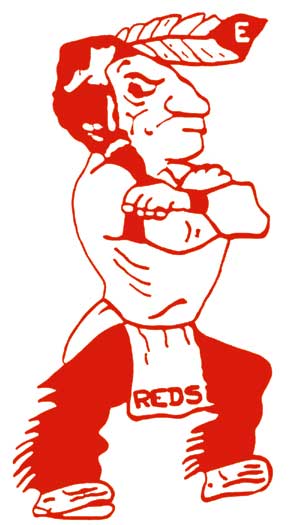
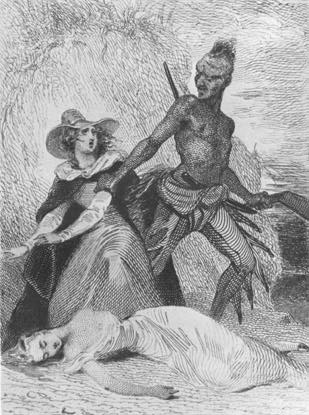
FSU's long history of hostility and abuse
August 17, 2005
FSU worked to cultivate better image of Seminole
BY AARON DESLATTE
FLORIDA TODAY
TALLAHASSEE -- Christine McCall had just come home from visiting Florida State University's campus when members of her tribe approached her.
"Everybody was asking me about how I felt about the use of the name," said the 18-year-old freshman from Hollywood, who is one of seven Seminole Indians enrolled on scholarship at FSU. "They were just asking me what I thought about it, and if FSU was using us in a bad way."
McCall confessed she hadn't thought much about images like the famous Seminole half-blood Chief Osceola driving a flaming spear into the turf at Doak Campbell Stadium before football games.
But among elders of the 3,100-member Seminole Tribe of Florida, the sentiment was stronger. "They've never been up there, and they don't really know what the opinion is. Are they respecting us, or are they just using us for a mascot like another school would use an animal?" McCall said.
That question drove the NCAA this month to impose a policy punishing Florida State and 17 other schools for using "hostile and abusive" American Indian mascots. Florida State University has defended its "nearly 60-year history of honoring the Florida Seminoles" in appealing the mascot ban.
But the relationship hasn't always been one of mutual respect.
In the 1950s, historically inaccurate Plains Indians bearing hatchets, and Chief Fullabull, who acted drunk at basketball games and ceremonially massacred opposing mascot effigies, were used.
Since, FSU has tried to make amends for its earliest depictions of Seminoles.
In the 1950s, the Seminole started showing up on campus as a cartoon design of a Plains Indian called Sammy Seminole. When Joyotpaul Chaudhuri arrived on campus in 1969, the political science professor was disgusted to see the basketball team's mascot, Chief Fullabull, perform his act.
"He would come out and make a fool of himself on the floor. If they were playing Arkansas, maybe he would get a fake pig and stab it, and blood would go everyplace," said Chaudhuri, whose late wife, Jean Chaudhuri, was a full-blooded Creek Indian from Oklahoma.
When Joyotpaul and Jean Chaudhuri traveled to the Seminole reservations in South Florida, they told then-Chief Howard Tommie and tribal leaders how the Seminole was depicted.
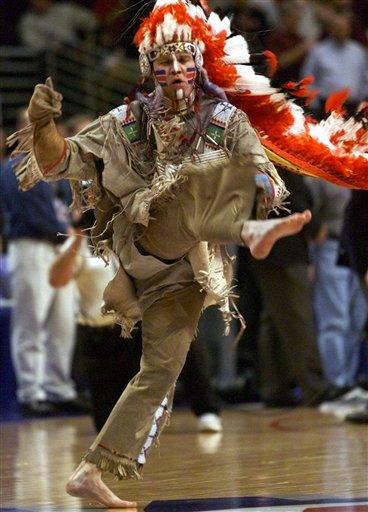
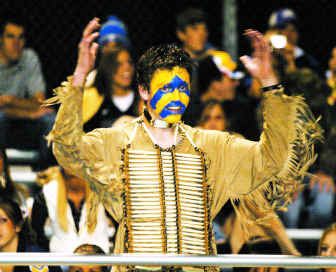
"They were upset," Chaudhuri recalled. "They didn't know because very few of them came up to Tallahassee to see a basketball game." After paying the campus a visit, Seminole leaders persuaded FSU to drop Chief Fullabull as its mascot. Sammy Seminole disappeared from the Florida Flambeau, the student newspaper, in 1972, according to university records. Formal recognition from the tribe for using the name and symbols came in 1975.
In 1978, the tribe also worked with the school to develop the Chief Osceola mascot. It wasn't until 1992 that the Tribal Council would ask FSU to retire the image of a chief running with a hatchet. The current Seminole images were trademarked in 1980-81.
More on Sammy Seminole from Suzan Shown Harjo. In Indian Country Today, 9/29/05:
UND once called its sports team "Sammy Sioux" and FSU's team was "Sammy Seminole." The term "Sammy" was used by some white Europeans and Americans as a pejorative for people of color -- primarily Africans, East Indians and African-Americans -- and was synonymous with "blackie," "darkie" and worse.
In the 1960s and 1970s, both African- and Native Americans undertook campaigns to eliminate the term. African-Americans concentrated on the use of the term in "Sambo's" restaurants. American Indians focused on the sports team names.
And:
While [Seminole Attorney Jim] Shore lauds the good deeds and intentions of FSU, the school's Web site tells a different story, bragging that the "tomahawk chop" started at one of their games and mentioning that only a handful of Seminole people have been students there.
To reiterate, the traditions that the NCAA threatened include "historically inaccurate Plains Indians bearing hatchets, and Chief Fullabull, who acted drunk at basketball games and ceremonially massacred opposing mascot effigies." A "chief bearing a hatchet" wasn't retired until 1992.
And what is the new and supposedly improved mascot? A scowling, warpainted "Chief Osceola" who throws a flaming spear at midfield. In short, the proverbial spearchucker. Yet the masses don't see this as problematical?
Given this history, I'm amazed people think FSU has a noble tradition of honoring Indians. To me the history seems a lot closer to the NCAA's estimation of hostile or abusive. If I didn't know better, I'd conclude, based on FSU's mascots, that Indians were bloodthirsty savages who sought only to kill or conquer people.
So what if FSU axed its hatchet-wielding chief a mere 13 years ago? The long history of Chief Fullabull and Sammy Seminole shows the school's real intent—the intent governing the original choice of the name "Seminoles." It wasn't to honor Indians, it was to mock or belittle them. Sammy Seminole might as well have been named "Little Red Sambo."
"We want to kill or conquer our opponents like these bloodthirsty savages did," FSU seemed to say, "but we don't think much of them otherwise. They're drunks, brutes, pigstickers—not fit for polite society except as performing poodles." To be a Seminole spearchucker—wow, what an honor for an Indian doctor or lawyer.
Chief Fullabull and Sammy Seminole fit the traditional role of a mascot: a sidekick, a lucky charm, a warm and lovable plaything. It's no coincidence that your classic mascot is someone dressed up as a fuzzy dancing animal. Even if FSU's "Chief Osceola" is supposed to be fierce, he's still playing the diminutive mascot role. Again, why would a real Indian want to be someone else's pet?
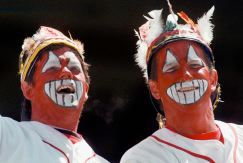
Fans are still hostile and abusive
Woods describes the fans' behavior at a typical Seminole game:
[T]he Seminoles were on top this day, and their fans, many splattered with garnet and gold war paint, had their own traditions. They sang along as the band played the traditional war chant of the FSU Seminoles:
Ohhhhhh, oh oh-uh-uh ohhhhh
Oh-uh-uh-ohhhhh
Oh-uh-uh-ohhhhh
As they chanted, they did their traditional "tomahawk chop," whereby they brought their forearms up and down to demonstrate how their fierce namesakes would slice up enemies.
From a letter to the Tallahassee Democrat, 6/22/05, titled It's How Fans, Not FSU, Portray Native People:
FSU still doesn't get it! The mascot issue is not only about how FSU portrays native people but also about how others do. The university can control its portrayal, but it cannot regulate misuse and abuse by fans.
LANCE LANE
Casa Grande, Ariz.
If you're a Native student at FSU, or simply a Native football fan, tens of thousands of people portray you as an axe-murderer every Saturday afternoon. But that's not hostile or abusive? The hell it isn't.
More hostility and abuse
Racist cartoon in the Knoxville News Sentinel
NCAA does an about-face
Faced with unrelenting pressure from FSU and sports fans around the nation, the NCAA reversed its decision for the FSU Seminoles, the Central Michigan Chippewas, and the Utah Utes. Lerch explains how it went down:
The NCAA made a huge error recently, taking a major hit to its credibility as a result. I'm not talking about its decision to ban Native American mascots and imagery at NCAA sponsored events, but rather backing down to Florida State and overruling itself on the use of Seminole imagery, especially Chief Osceola.
Now North Dakota has thrown down, obviously emboldened by FSU's whining and the NCAA's almost immediate capitulation.
If you're going to make a bold, progressive move, and God knows the NCAA needs to make more of those, then don't back right down in the face of resistance. Send Chief Osceola, the "Fighting Sioux" and the rest to the scrap heap of history where they belong, right next to Little Black Sambo, minstrel shows, and other racist symbols and imagery that, gradually over time, we've figured out are just plain wrong.
High schools and colleges have been abandoning this practice in droves in recent years, and the NCAA identified 18 holdouts and decided it was time to get tough. Well, tough for the NCAA anyway. On August 5, it issued an edict prohibiting racist mascots and symbols at NCAA tournament games. This was a shot across the bow at North Dakota, which is hosting the 2006 NCAA West Regional. In what was surely an in-your-face gesture to critics, UND's Engelstad Arena is adorned with thousands of Fighting Sioux logos. As things stand now, they'll all have to be covered up.
But FSU has persuaded the NCAA to change its mind, making the folks in Indianapolis look foolish. No new facts had come to light — Florida State had always claimed that it has the endorsement of the Florida Seminole tribe. That's irrelevant, akin to allowing a sports team to be named "The Negroes" (or worse) because it was all right with the local black population.

What's behind FSU's choice of "Seminoles"?
From Nicknames & Mascots: Complicity in Bigotry by Keith M. Woods (Poynter Institute, 8/17/05):
So impressed by the indomitable spirit of The Indian were schools like Florida State, we are now to believe, that they appropriated their name (at a time when, surely, they wanted nothing to do with actual Indians), invented a likeness, and now send a horse-borne student galloping across a football field before a tomahawking crowd in the name of honor and respect.
.
.
.
But you don't have to scratch Chief Osceola's war paint very long to know that it's not Native American tradition under there. What's really at stake is the tradition of the alumni at the likes of Florida State, Alcorn State and Southeastern Oklahoma State (home of the "Savages"), all desperate to hold onto their rituals, their trademarks and their hot-selling T-shirts. Thus, they retrofit arrogance with honor, just as their ancestors might have sprinkled spices on rotting meat.
Why the Florida Seminoles support FSU
From Lane's letter to the Tallahassee Democrat, 6/22/05:
I guess one could have predicted that FSU would call upon the Seminole Tribe of Florida to endorse its use of the Seminole name and imagery, with pressure from the NCAA on Indian mascots.
What did FSU think would happen? Would the tribe risk alienating lawmakers by not giving the endorsement and further jeopardizing its political interests? Does FSU think that the tribe is going to want the university to stop advertising for it? Shame on the FSU and its boosters for putting the tribe in that position.
From Native Dignity in North Dakota by Suzan Shown Harjo. In Indian Country Today, 9/29/05:
Shore winds up his story of Seminole "accommodation" in this way: "And then there's the university's impact in Tallahassee. Hundreds of Florida government officials are [FSU] graduates and supporters. We deal with these people every day."
From The NCAA Is Learning What It's Like to Be Indian by Suzan Shown Harjo. In Indian Country Today, 8/11/05:
The excuse from the Native deal-makers in Florida, Michigan, Oklahoma and Utah is this: if we give them what they want for sports, they'll leave our casinos and land alone.
This isn't too hard to understand. The Seminole Tribe is largely dependent on the whims of the federal and state governments for its livelihood. In the case of gaming, the tribe and state are business partners. Why would a relatively weak tribe do anything to jeopardize its government-to-government relationships? Enduring a mascot is nothing compared to having the state (or the feds, at the state's request) shut down its businesses or curtail its access to social services.
If the tribe seems to be embracing FSU's mascot, well, think of the PR value. Because it's approved the mascot, it can tell people how benign and cooperative it is. "We aren't fighting the state of Florida," the mascot implicitly says. "We're friends and partners. Look, we even lent our name and image to a state university. How can you question or oppose us when we're all on the same (football) team?"
Not only does the tribe score points for cooperating, but the name and mascot generate free PR for its casinos and other businesses. There's nothing wrong with using one's assets for publicity, but it's not the same as approving the use of mascots in theory. As with any company that uses cartoon characters to sell its products, it's a business decision, not a moral one.

When the Seminole Tribe approves the use of its name and mascot in sports even though it has no conflict of interest whatsoever, then I'll believe its decision is free and clear. Until then, "calculated" seems a better word for it.
FSU's Seminoles in the Stereotype of the Month contest
Seminoles' black helmets imply Indians were spearchuckers
U. of Florida cartoon: NCAA scolds Gator killing Seminole
"Anti-Indians" want to remove every Indian name in the US
"Condescending" NCAA tells Indians what's best for them
NCAA thinks "Seminoles" is stereotype, not actual name
Dobbs: Mascot ruling is an "Orwellian exercise," "idiotic"
NCAA decides for Indians "without their express consent"
More on FSU's Seminoles
Seminole mascot wore pantyhose
The FSU spearchuckers
Relation of FSU, tribe distinctive
It's a Seminole weekend at FSU
FSU to teach Seminole history
Related links
Team names and mascots
Fighting the Fighting Sioux
Fighting Sioux vs. Fighting Irish
Red·skin n. Dated, offensive, taboo
Readers respond
"To experience a free society, we have to, each one of us, accept trespass to preserve tolerance."
|
. . . |

|
All material © copyright its original owners, except where noted.
Original text and pictures © copyright 2007 by Robert Schmidt.
Copyrighted material is posted under the Fair Use provision of the Copyright Act,
which allows copying for nonprofit educational uses including criticism and commentary.
Comments sent to the publisher become the property of Blue Corn Comics
and may be used in other postings without permission.